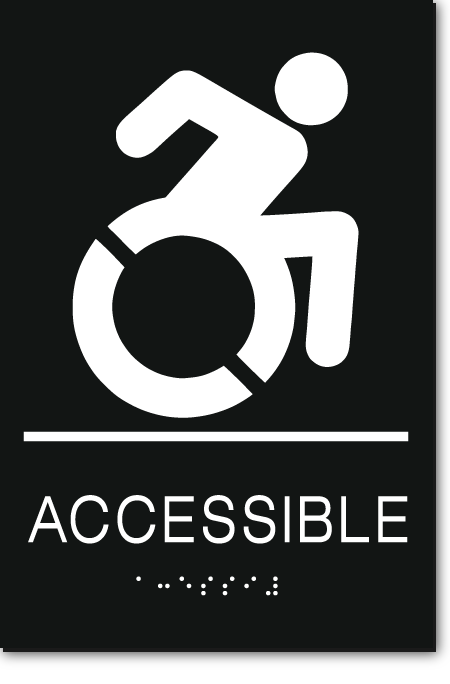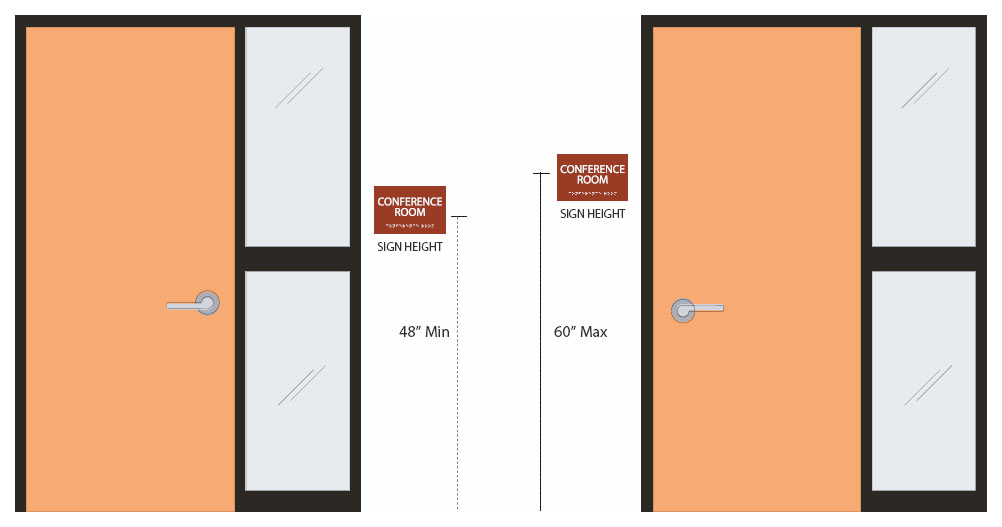Customizing ADA Signs to Satisfy Your Specific Requirements
ADA Signs: Making Certain Availability and Conformity in Public Spaces
ADA signs plays a crucial function in assuring accessibility and conformity within public spaces, significantly adding to an inclusive environment for people with disabilities. By adhering to ADA requirements, signage not just helps with navigation however additionally emphasizes an organization's commitment to variety and equality. As we discover the subtleties of ADA signs, from tactile attributes to create ins and outs, it's critical to think about how these elements coalesce to maintain the rights of all individuals. What are the usual challenges companies face in maintaining conformity, and how can future patterns in signs proceed to drive availability ahead?
Significance of ADA Signage
In modern-day society, the significance of ADA signs expands beyond simple conformity with lawful requireds to symbolize a commitment to inclusivity and ease of access for all people. These indicators are necessary in creating environments where people with disabilities can navigate public areas with the very same simplicity and independence as those without impairments. By giving standard and clear details, ADA signage makes certain that everyone can access centers, services, and info without barriers.
The value of ADA signs depends on its capability to boost the lifestyle for people with specials needs by promoting equivalent accessibility. It removes the challenges that might or else hinder their capability to take part totally in area life. Furthermore, these indicators serve as noticeable signs of an organization's commitment to diversity and equal rights, mirroring broader societal values that champion the rights and self-respect of all people.
Moreover, ADA signs plays a crucial duty in public safety and security. By guiding individuals to departures, washrooms, and various other essential facilities, it makes sure that all individuals, despite physical capacity, can leave securely during emergency situations. In recap, ADA signage is not simply a governing demand however a powerful device for cultivating a fair and inclusive culture.
Trick Aspects of Compliance

Placement is vital; signs have to be set up in areas that are conveniently noticeable and reachable. Normally, signs needs to be placed in between 48 and 60 inches from the ground to make sure availability for both standing and wheelchair customers. Tactile aspects, such as Braille, are essential for people with aesthetic impairments, providing crucial info in a non-visual layout.
High-contrast shades in between the text and history are essential to improve readability for individuals with low vision. The ADA mandates particular contrast proportions to make sure clarity. In addition, character size is a vital factor to consider, with minimal height requirements dictated by the seeing range to make sure readability from numerous angles.
Design Considerations for Accessibility
Designing easily accessible signs calls for a thorough approach to guarantee it meets the needs of all customers, specifically those with handicaps. This entails taking into consideration different style aspects that improve readability and usability. Key variables include the option of font style, color comparison, and tactile features. Font styles need to be sans-serif, with clear and easy letterforms, to assist in very easy reading. The size of the message is just as important, with ADA guidelines recommending a minimal elevation based on seeing range to make certain clarity.
Contrasting colors in between text and history are essential for exposure, especially for individuals with aesthetic problems. A high contrast proportion helps identify the message from its background, improving readability under different illumination conditions. Additionally, tactile aspects, such as Braille and elevated personalities, are important for individuals who are blind or have low vision. These components ought to be situated at a regular height and position to make sure easy access and comprehension.
Moreover, the positioning of signage plays a considerable role in accessibility. Indicators need to be mounted in locations that are quickly obtainable and unhampered. Guaranteeing that signage is mounted at appropriate heights and angles makes it possible for all individuals, consisting of those making use of mobility devices, to interact with them effectively.
Common Errors to Avoid

One more prevalent error is the wrong positioning of signage. ADA guidelines specify precise height and area needs to ensure that indications are quickly noticeable and obtainable by all individuals, including those making use of mobility devices. Disregarding these standards not only hampers accessibility but also runs the risk of non-compliance with legal criteria.
Additionally, inadequate contrast in between message and history is a constant oversight. Adequate contrast is important for readability, particularly for people with reduced vision. Developers in some cases select colors that are visually appealing yet do not have the essential comparison, making the text hard to recognize.
Last but not least, some designers fail to incorporate tactile components, such as Braille, which are important for individuals who are blind. Leaving out these functions not just causes non-compliance with ADA laws but additionally limits access for a segment of the population that depends on responsive details.
Future Trends in Signage
Improvements in modern technology and boosting recognition of inclusivity are shaping the future trends in signage layout. As society ends up being more aware of diverse demands, the integration of view publisher site clever modern technologies into signs is gaining grip. Digital signage, for circumstances, is advancing to consist of real-time updates and interactive attributes, which can be important in offering vibrant details in public rooms. These indications typically include touch screens or gesture-based controls, making it possible for individuals to browse material customized to their specific requirements.
One more arising fad is the application of augmented reality (AR) to improve customer experience. AR-enabled signage can overlay digital information onto the physical atmosphere, offering aesthetically damaged individuals with auditory or haptic feedback. ADA Signs. This modern technology not just improves ease of access yet likewise creates an interesting experience for all users
Sustainability is likewise a substantial variable affecting signs trends. Green products and energy-efficient illumination options are being prioritized to straighten with worldwide ecological objectives. Moreover, developments in materials scientific research are leading to the development of more weather-resistant and durable indications.
Conclusion
ADA signage plays a vital role in ensuring accessibility and conformity within public areas by incorporating responsive aspects, high-contrast colors, and tactical placement. view The adherence to ADA standards not just helps with risk-free navigating for individuals with handicaps but also represents a company's dedication to diversity and inclusivity. By preventing usual blunders and welcoming future fads, public spaces can remain to progress these values, ensuring that the rights and dignity of all people are valued and promoted.
ADA signs plays a vital role in assuring access and conformity within public areas, considerably adding to a comprehensive atmosphere for individuals with specials needs. As we discover the subtleties of ADA signs, from tactile features to design complexities, it's critical to think about exactly how these aspects coalesce to promote the rights of all users.In contemporary society, the value of ADA signs expands beyond mere conformity with lawful mandates to personify a commitment to inclusivity and ease of access for all people. By giving standardized and clear information, ADA signage guarantees that everyone can access facilities, solutions, and information without obstacles.
ADA signs plays a crucial role in ensuring accessibility and compliance within public rooms by including responsive components, high-contrast shades, and tactical positioning. (ADA Signs)